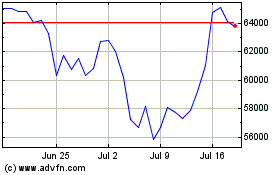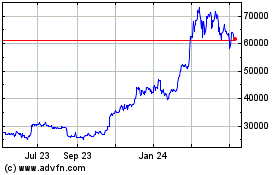Bitcoin Loses Correlation With US Equities As Supply Challenges Mount
July 10 2024 - 3:00AM
NEWSBTC
In recent months, the correlation between surging US equities and
Bitcoin (BTC) has shown signs of collapse, as the cryptocurrency
faces a combination of excess supply and weakened demand that has
led to an over 20% price drop from June highs above $70,000 for the
largest cryptocurrency on the market. Bitcoin Correlation
With Nasdaq 100 According to Bloomberg, the 90-day correlation
coefficient between Bitcoin and the Nasdaq 100 index dropped to
0.21 on Tuesday, marking its lowest level since the beginning of
May. This decline reflects a more than 50% drop in correlation over
the past two months. Market experts attribute this decoupling
to several “idiosyncratic” supply events affecting Bitcoin. Joshua
Lim, co-founder of trading firm Arbelos Markets, explains that the
cryptocurrency is grappling with the impact of spot sales from
seized BTC held by the German and US governments experienced over
the past month, as well as the distribution of funds from the
defunct Bitcoin exchange Mt. Gox. Related Reading: Football
Takeover? Solana-Based Token Skyrockets 350% Following Messi and
Ronaldinho’s Promotion As reported by NewsBTC, Bitcoin’s decline
since its March all-time high of $73,700 has been accelerated by
the recent process initiated by Mt. Gox’s administrators to return
approximately $9 billion worth of tokens to creditors. In addition,
German authorities sold more than half of the 50,000 BTC seized
from a pirate website in January, adding to the ongoing selling
pressure seen last month. Manuel Villegas, research analyst
at Julius Baer, highlights the looming supply overhang as the
primary factor impacting market confidence. Villegas stated: Excess
token supply is expected to reach centralized exchanges in the next
few days, likely putting pressure on prices. The looming supply
overhang has been the main factor affecting confidence. Miner
Capitulation And Falling Profits In addition to these challenges
affecting BTC’s price, Bitcoin miners face pressure to sell tokens
due to declining profitability. These miners, responsible for
powering the Bitcoin blockchain, are dealing with the financial
fallout from April’s Halving event, which reduced the number of new
tokens they receive for their mining activities. In response,
some miners sell some of their BTC holding inventory to offset
their fiat-based operating costs. Data from crypto analytics firm
CryptoQuant shows that miner capitulation mirrors December 2022
levels with a 7.7% hashrate drop, similar to post-FTX collapse
conditions. Related Reading: Solana Mirroring 2021 Bullish Pattern,
Crypto Analyst Reveals According to estimates made by Bloomberg,
the average all-in cost of production for miners is approximately
$54,500. When prices fall significantly below this threshold,
miners may need to liquidate some token holdings to cover
operational expenses. Ultimately, the combination of supply
overhang from seized coins, the Mt. Gox distribution, and miners’
selling pressure has increased uncertainty for investors, further
affecting BTC’s price recovery. At the time of writing, BTC
has managed to recover the $57,850 level, surging over 2% in the
past 24 hours. Featured image from DALL-E, chart from
TradingView.com
Bitcoin (COIN:BTCUSD)
Historical Stock Chart
From Jun 2024 to Jul 2024

Bitcoin (COIN:BTCUSD)
Historical Stock Chart
From Jul 2023 to Jul 2024
